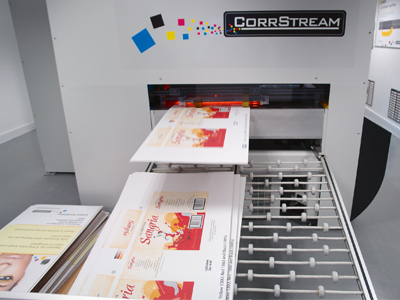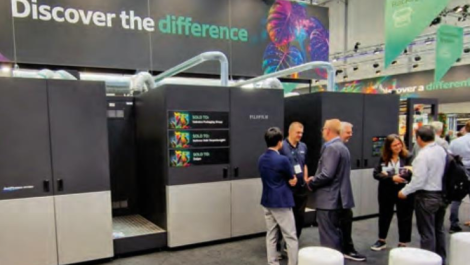Sun Automation’s CorrStream press
‘It has been a fascinating journey for inkjet technology in corrugated,’ says Sean Moloney, global product manager for digital at Sun Automation Group, in this opinion piece.
We have been hearing the words ‘digital’, ‘inkjet’ and ‘corrugated’ used in sentences for over 20 years, and there have been some recent adventures in flat bed, wide format, as box makers test the opportunities apparent in large format display and FSDU work, but this hardly sets the world alight, particularly against the highly capable and established POS print service providers already in this space.
Of course, some traditional corrugated plants are carving niches in POS and ultra-low unit volume RSC and SRP box production, with margins that remind us of days gone by. The challenges of the limited output credentials of multi-pass inkjet systems fail to excite the hardened box makers however.
Another limiting factor to digital adoption in box making is the chasm that exists between conventional print workflow and the workflow skills and set up needed to make digital printing work as it is capable of. The corrugated industry is well established with its tried and tested routine involving multiple exchanges between the brand/retailer, the customer, the box plant, their repro and platemaker and the ink suppliers. It is a wonder a box gets delivered at all! It of course does as each of these parties has become highly tuned to ensuring they take their part of the box income available.
Compare this to the digital workflow opportunity and benefits are clear – less touch points and potentially more value for the box maker. It is the leap to a workflow that entails brand/retailer/user direct to box maker that for many is attractive on paper, but for most is a scary proposition in practice. I guess the safety blanket of the tried and trusted is a strong one.
While dealing with multi-pass inkjet presses that won’t see more than 4000 square metres in a typical shift, a few intrepid box makers have made this leap and to great effect. Proving the case that margin is not only a result of the act of printing when it comes to digital corrugated. By their own volition this journey has not been easy – especially as the OEMs involved were happy to sell a printer, but were less positive in supporting the corrugated producer in ensuring a workflow suited to box making. In any case we see many are very happy with the trajectory they are on into the brave new world. Confirmed by the fact inkjet based investments are rising year on year in our industry.
So what next?
Well, the next generation of digital printers raises all these questions and more. Questions that to be answered need to have the benefits of digital corrugated discussed first. Box makers appreciate where the value resides both in the product and the supply chain. The challenge in an increasingly consolidated industry with fewer industrial users of boxes is one of margin. A problem compounded as the box producers equalise their equipment capabilities across the work mix from brown RSC to on shelf HQPP and pre-print.
High volume digital corrugated breathes new life into this highly competitive environment in four key ways:
1. Reduced lead time and shorter time to market.
2. Reduced inventory and improved cashflow.
3. Limitless print versioning, with no loss to box volume, at no extra cost, providing customers with increased opportunity for on shelf sales.
4. Opportunity to enter new markets within multi-channel supply chains, including online, B2B and B2C markets.
These benefits demand a complete understanding of workflow required prior to printing if they are to be successfully achieved. High output, single pass, digital corrugated should not be considered unless the pre-press workflow and associated IT, ideally all the way back to the box user, is understood and the necessary placed in tandem with the printer itself.






